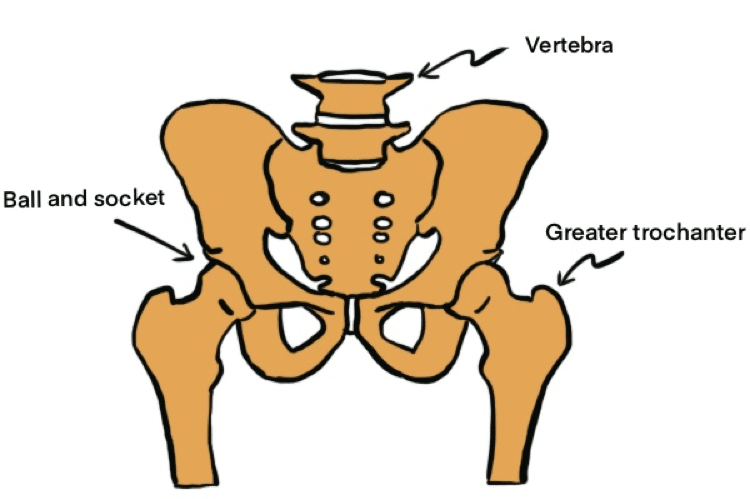Why Does My Hip Hurt?
F. Thane Deweese, MD | December 14, 2020
Hip pain is caused by a variety of conditions. To better understand these conditions, a basic anatomy lesson is helpful. Please refer to Figure 1 and the following description. First, the bony bricks, called vertebrae of the lower back, join the top of the bony pelvis just above the buttocks. Second, towards the bottom and front of the bony pelvis, on either side, is a spherical bony depression, or socket. Each socket accepts the ball on the top end of the thigh bone at the hip joint. Third, just below the hip joint is a bony knob that extends off the side of the thigh bone called the greater trochanter. This trochanter is a key point of attachment for muscles originating from the pelvis.
Figure 1. Illustration of the bony pelvis.
In addition to the bony anatomy, there are important soft tissues around the hip. Many muscles connect and cross from the lower back to the pelvis and down past the hip to the thigh bone. Major nerves and arteries also cross this area. Further, the pelvis holds major organs such as the intestines and bladder.
Now that we understand how the parts go together, let’s look at the list of conditions that can affect these parts and cause hip pain. Most hip pain is caused by one of the following conditions:
1. Lumbar degenerative disk disease (DDD)
The cushions and connections of the lower back vertebra wear out causing pain and stiffness. Due to the way the body is wired to feel pain, this pain is often felt in one or both buttocks.
2. Greater trochanteric bursitis
Tightness and fraying of the muscle tendons that attach to the trochanter cause pain on the side of the hip.
3. Hip osteoarthritis
The hard shiny cartilage coating the ball and socket wears away causing severe groin pain, often extending down the front of the thigh.
Much less common conditions include:
- Sacroiliac arthritis
- Vascular claudication
- Stress fracture
- Piriformis syndrome
- Inguinal hernia
- Labral tear
- Infection
- Cancer
Sacroiliac arthritis is where a seam joint in the backside of the bony pelvis wears out causing buttock pain. Vascular claudication is where the big muscles around the hip are starved for oxygen due to poor circulation. This usually results in deep buttock and leg pain that is worse with activity and improves with rest. The piriformis is a small muscle, deep in the back of the hip, that can get too tight and pinch the sciatic nerve resulting in deep buttock pain. A labral tear is a tear of a rubber gasket that fits around the edge of the hip socket. It results in groin pain and sometimes a clicking or catching. The other listed conditions are self-explanatory.
Which one of these offending conditions is causing hip pain must be determined before it can be treated effectively. Sorting it out is usually straightforward. The first thing I ask the patient is to point to where their hip hurts the most. If they point to their buttock, the pain is most likely due to a problem with their lower back referring pain to this area. If they point to the side of their hip they usually have bursitis of the greater trochanter. If they point to their groin then the pain is most likely coming from the hip joint itself.
Pain in the side of the hip due to bursitis is aggravated by lying on the affected hip. Pain in the groin due to a problem with the hip joint is aggravated by putting on socks and shoes. Pain that never goes away and or wakes you from a sound sleep could be an uncommon but serious condition that warrants immediate evaluation.
Physical examination further supports/confirms the cause of pain. Buttock pain due to lumbar DDD is worsened by extending the lower back and leaning to the affected side. If the patient’s upper body leans over the affected hip during the stance phase of gait this points to the hip joint itself as the source of pain. Good pulses in the leg and foot and normal strength and sensation rule out problems with circulation or nerve.
X-rays are helpful to further nail down the problem. Hip arthritis is seen as a narrowing of the space between the ball and socket. Narrowed space between the vertebrae of the lower back point to lumbar DDD. Occasionally an MRI can pick up less common cause of hip pain such as tendon/muscle injury, pinched nerve, fracture, cancer, or infection. Occasionally, an injection of anesthetic combined with cortisone into the hip joint or greater trochanter is often helpful to confirm the cause of pain.
That’s a lot of information packed into a few paragraphs. Hope it helps as you start to figure out what’s causing your hip pain. You don’t have to read this manual and try to figure it out by yourself. Any of our orthopedic specialists at the Orthopaedic Institute of Western Kentucky would love to help you figure out what is causing your hip pain and fix it! Please call us at 270-442-9461 to schedule an evaluation today.

